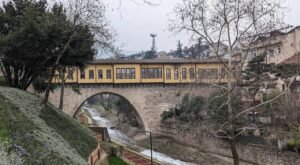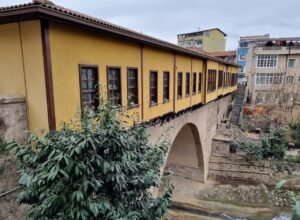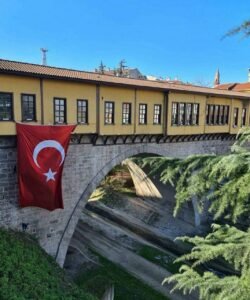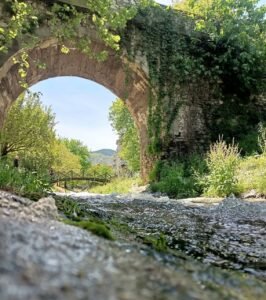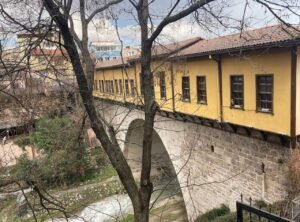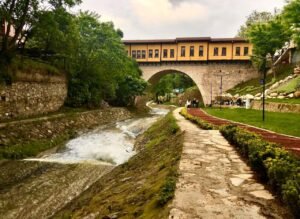Description
Discovering Irgandı Bridge: A Timeless Jewel in the Heart of Bursa, Turkey
Tucked away in the historic city of Bursa, Turkey, the Irgandı Bridge (Turkish: Irgandı Köprüsü) is one of the few bridges in the world that hosts a bazaar above a flowing river. Built with both architectural elegance and commercial function in mind, this charming bridge offers more than just a crossing—it offers a journey through history, culture, and craftsmanship.
A Bridge Like No Other
Unlike typical bridges, the Irgandı Bridge stands out for its rare concept: a covered bridge with shops on it. There are only a handful of such bridges globally—examples include the Ponte Vecchio in Florence and the Krämerbrücke in Erfurt, Germany. Irgandı, however, is the only one of its kind in Turkey, making it a national treasure and a fascinating destination for tourists.
Spanning the Gökdere River in central Bursa, this modest yet picturesque bridge measures around 11 meters wide and 16 meters long. While its dimensions are not grand, its historical and cultural significance is immense.
A Glimpse into History
The Irgandı Bridge dates back to 1442, during the reign of Sultan Murad II of the Ottoman Empire. It was commissioned by a wealthy merchant named Müslihiddin Irgandı, from whom the bridge takes its name. Constructed with yellow stones sourced from local quarries, the bridge originally housed more than 30 artisan shops.
During the Ottoman era, bridges were not only functional infrastructures but also social spaces. The shops on the Irgandı Bridge served as a vibrant commercial hub for silversmiths, weavers, leather workers, and other skilled craftsmen. Travelers crossing the bridge could pause to browse handmade goods or commission unique items—blurring the lines between commerce and connection.
Unfortunately, the bridge suffered severe damage during the 1855 Bursa earthquake and later, in World War I, it was bombed by retreating Greek forces. For decades, the bridge stood in disrepair, a ghost of its former self. It wasn’t until 2004 that Irgandı Bridge was carefully restored to its former glory, thanks to a citywide project aimed at reviving Bursa’s historic landmarks.
A Cultural and Artistic Sanctuary
Today, Irgandı Bridge is once again alive with the spirit of creativity. The shops that line the bridge are no longer bustling with blacksmiths or silk traders, but with modern artisans and boutique craft sellers. You’ll find studios offering calligraphy, marbling (ebru), miniature painting, jewelry, ceramics, and more. Many of these artists are happy to chat with visitors about their work or even provide short workshops.
Walking across the bridge feels like stepping into a living museum. Each shop is a little treasure trove of Turkish heritage, combining traditional techniques with contemporary artistry. The atmosphere is quiet and reflective—perfect for those looking to escape the busier tourist spots and experience something more intimate and authentic.
Architectural Elegance
Architecturally, Irgandı Bridge is a fine example of Ottoman civil engineering. Built on a single arch, the bridge boasts clean lines and a harmonious balance with its surroundings. The yellow stones and wooden shopfronts give it a warm, welcoming aesthetic, and the bridge’s elevation offers pleasant views of the Gökdere River below and the hills beyond.
Notably, the bridge sits close to the foot of the Uludağ Mountain and is just a short walk from other historical sites in Bursa such as the Green Mosque (Yeşil Cami), Green Tomb (Yeşil Türbe), and the Grand Bazaar. This makes Irgandı an excellent stop on a historical walking tour through the city’s rich Ottoman past.
A Photographer’s Paradise
Due to its unique appearance and serene setting, Irgandı Bridge is a popular subject for photographers and artists. Whether you're capturing it from the cobbled pathways below or from one of the bridge’s shop windows overlooking the river, the angles and colors offer endless inspiration.
Sunrise and sunset cast a golden glow on the stonework, while the reflection of the bridge in the water creates an almost poetic symmetry. In the winter, when light snow dusts the rooftops, the bridge looks like something out of a storybook.
Practical Information for Visitors
Getting There: Irgandı Bridge is easily accessible from the center of Bursa. If you're traveling from Istanbul, you can take a ferry to Mudanya and continue by bus or car to Bursa. The bridge is within walking distance of major landmarks and city attractions.
Opening Hours: As the bridge is a public thoroughfare, it is open 24/7. However, the artisan shops generally operate from around 10 AM to 6 PM, and some may close on Sundays.
Entry Fee: There is no entrance fee to cross the bridge or explore the shops, making it an affordable yet enriching cultural experience.
What to Do Nearby:
-
Visit the Koza Han, the ancient silk bazaar nearby.
-
Tour the Green Mosque and Tomb, iconic examples of early Ottoman architecture.
-
Explore the Cumalıkızık village, a UNESCO World Heritage Site, just a short drive away.
Why Visit Irgandı Bridge?
In an age of high-speed travel and instant gratification, Irgandı Bridge invites you to slow down. It’s not a place of loud crowds or flashy attractions, but a quiet celebration of Bursa’s artisanal heritage and resilient spirit. Whether you’re a history buff, a lover of art, or simply someone who enjoys uncovering hidden gems, the Irgandı Bridge is a must-see destination that encapsulates the charm of a bygone era.
So next time you’re in Turkey, don’t just pass through Bursa—cross the Irgandı Bridge, and discover a piece of living history.
Location
-
Kurtoğlu, Gökdere Blv. No:14, 16360 Yıldırım/Bursa

